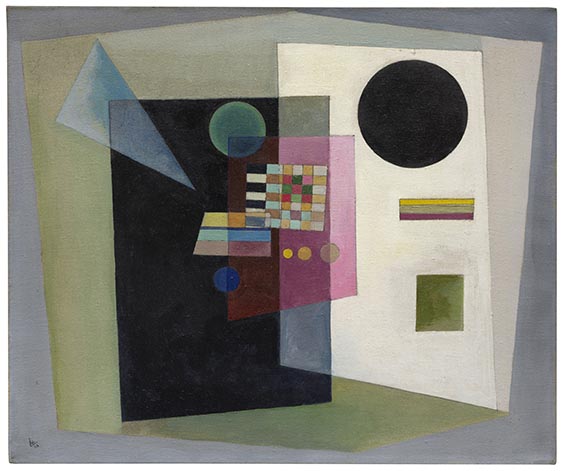Dictionary


Biomorphic Abstractions before 1945
The term "biomorph" derives from the Greek word for form (morphe) and refers to cycles and changes based on biological activities. Biomorphic abstraction in art describes artistic designs that are non-objective, organic, and thus also often resemble amoeba observed under a microscope. The term was first used in an artistic context by Alfred H. Barr Jr in 1936. Biomorphic forms can be seen in the work of Jean (Hans) Arp, Wassily Kandinsky, Fritz Winter, and the Surrealists, Salvador Dalí, Max Ernst, Joan Miró and Yves Tanguy. The biomorphic shapes in Jean Arp’s (1887-1966) graphic, painting and sculptural works after late 1910, were referred to as "earthly forms". Arp developed these curvy-lined, frequently ovoid forms, from his observation of natural materials, the inspiration for his work. For Arp, these forms were a symbol of life.
Somewhat later than Arp, and whilst he was living in French exile, Wassily Kandinsky (1866-1944), incorporated biomorphic forms into his work. Their organic appearance distinguished them radically from the artist’s geometrically composed images. For Kandinsky, these floating biomorphic forms carried inner sensations, and gave expression to his belief that the artist could speak of "the expression of mystery by means of mystery".
The term "biomorph" derives from the Greek word for form (morphe) and refers to cycles and changes based on biological activities. Biomorphic abstraction in art describes artistic designs that are non-objective, organic, and thus also often resemble amoeba observed under a microscope. The term was first used in an artistic context by Alfred H. Barr Jr in 1936. Biomorphic forms can be seen in the work of Jean (Hans) Arp, Wassily Kandinsky, Fritz Winter, and the Surrealists, Salvador Dalí, Max Ernst, Joan Miró and Yves Tanguy. The biomorphic shapes in Jean Arp’s (1887-1966) graphic, painting and sculptural works after late 1910, were referred to as "earthly forms". Arp developed these curvy-lined, frequently ovoid forms, from his observation of natural materials, the inspiration for his work. For Arp, these forms were a symbol of life.
Somewhat later than Arp, and whilst he was living in French exile, Wassily Kandinsky (1866-1944), incorporated biomorphic forms into his work. Their organic appearance distinguished them radically from the artist’s geometrically composed images. For Kandinsky, these floating biomorphic forms carried inner sensations, and gave expression to his belief that the artist could speak of "the expression of mystery by means of mystery".
Offers
Headquarters
Joseph-Wild-Str. 18
81829 Munich
Phone: +49 89 55 244-0
Fax: +49 89 55 244-177
info@kettererkunst.de
Louisa von Saucken / Undine Schleifer
Holstenwall 5
20355 Hamburg
Phone: +49 40 37 49 61-0
Fax: +49 40 37 49 61-66
infohamburg@kettererkunst.de
Dr. Simone Wiechers / Nane Schlage
Fasanenstr. 70
10719 Berlin
Phone: +49 30 88 67 53-63
Fax: +49 30 88 67 56-43
infoberlin@kettererkunst.de
Cordula Lichtenberg
Gertrudenstraße 24-28
50667 Cologne
Phone: +49 221 510 908-15
infokoeln@kettererkunst.de
Hessen
Rhineland-Palatinate
Miriam Heß
Phone: +49 62 21 58 80-038
Fax: +49 62 21 58 80-595
infoheidelberg@kettererkunst.de
We will inform you in time.




